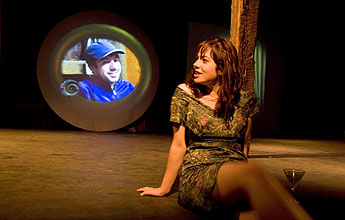December 5, 2005
Digital Arts grad students shine in collaboration with theater troupe
By Scott Rappaport
In Nightingale—the first thesis project of UCSC’s new graduate program in Digital Arts/New Media—dancers onstage trigger digital effects through their intricate movements, creating streams of light and colors that appear on images of their bodies projected on screens behind them.

Student dancers trigger digital effects that appear on screens behind them.
Photos: Jim MacKenzie |
Featuring video illuminated on three screens, interactive digital media, theater improvisation, and original sonic compositions, Nightingale is the result of an ambitious collaboration between five Digital Arts/New Media graduate students and BarnStorm, the new student-run company of UCSC’s Theater Arts Department.
The production was choreographed by assistant theater arts professor Ted Warburton, who worked with student media designer Jess Damsen to pilot the use of a technology called ActiveSpace, developed by professor John Crawford at UC Irvine. With computer hardware newly purchased by the Digital Arts/New Media program, UCSC students can now take advantage of an interactive dance system that allows dancers to generate digital effects from their movements on stage.
“The basic idea is that one camera captures the image of a dancer, another camera registers the movement of that dancer onstage, and that movement triggers effects depending on how they are programmed,” explained Porter College lecturer and DANM grad student Bob Giges. “The effects are then projected on screens behind the dancer.”
Giges wrote the script for the production for his M.F.A. thesis project, taking the classic Hans Christian Andersen tale of The Nightingale and embedding it into a contemporary story about relationships in turmoil. He said he deliberately included additional forms of live interaction to draw the audience in.
“We would interview audience members before the show and ask them probing questions about their relationships—such as ‘what problem do you need to tell your partner about urgently?’ said Giges. “We recorded all their answers on a digital recorder. And as the writer of the play, three times I called for playback of these testimonies, which led to improvisation by the romantic leads--who incorporated the problems of the audience into the relationships of their own characters on the stage.”
Nightingale was directed by Digital Arts/New Media grad student Timothy Jordan and featured a number of undergraduate and graduate students from a variety of disciplines in all of the acting roles and technical positions. Giges said the production took more than six months to launch, culminating in five performances in November at the Barn Theater.
Giges, who has taught film and writing classes at Porter College for the past 25 years, will graduate with UCSC’s first Digital Arts/New Media M.F.A. class in June. He said he plans to rewrite the Nightingale script and send it around to major venues to see if it can be produced professionally. Giges added that he is proud of UCSC’s new graduate program, which he helped develop as an assistant to the Arts Division dean in 2001.
“The M.F.A. is the highest degree for artists, and we have never had a professional training ground for artists at UCSC,” Giges noted. “The M.F.A. is definitely a significant feather in the cap for the campus.”

Actors improvise in live interactions with taped interviews of audience members recorded just before the performance.
|
 Email this story
Email this story
 Printer-friendly version
Printer-friendly version
 Return to Front Page
Return to Front Page